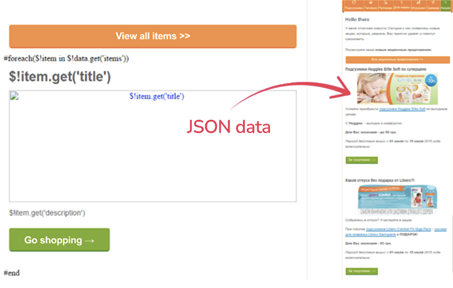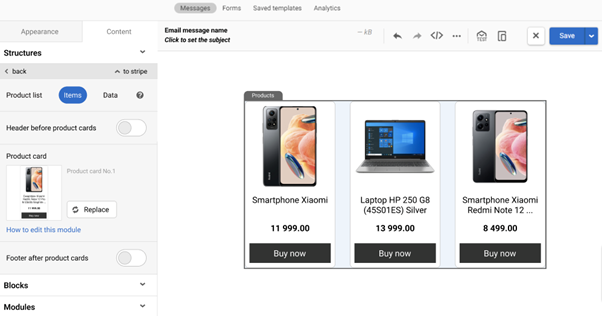Transforming Email Marketing: The Power of Modular Email Design
Modular email design is not just a trend — it's revolutionizing email marketing. Beyond well-crafted email snippets, modules offer a novel approach that reshapes email production workflows, allowing marketing teams to prioritize strategic initiatives over technical complexities.
Evolution of email production
Email has transformed over the past 50 years, adopting various production approaches ranging from plain text and HTML coding to WYSIWYG editors and modular design. The prevalent practice today leans heavily towards prebuilt templates. However, this is not the most efficient method. Templates are more of a marketing trick rather than a functional tool for email marketers.
Once you've chosen a template for your campaigns, you'll always have to modify it to meet the needs of your current email campaign.
Modules, in contrast, stand as independent content units — consistent in design and brand yet versatile in structure and purpose. They can be effortlessly combined and customized, marking a shift towards a more adaptive email design approach.
Luckily, today, the world is slowly transitioning from the template approach to the modular email design approach.
Modular email design: first iteration
Modular email design, alternatively known as modular email architecture, is gaining traction and is supported by many CDPs/ESPs and email builders.
This strategy:
- enhances brand consistency;
- optimizes email production in terms of time and cost;
- simplifies the design process;
- eliminates the need to run rendering tests every time a new campaign is launched;
- facilitates easy last-minute changes.
This is the traditional understanding of modules. However, they are capable of so much more.
Modules+, or modular email design: second iteration
A “Module+” is a content unit where data is dissociated from the design. Simply put, design and data operate independently. This is what, in my opinion, makes the modular email architecture a transformative philosophy, revolutionizing the email production experience.
Benefits of such an approach:
The design and the data of a module can be separated, allowing for flexibility in optimization and modification of design without affecting the data. You can create a structured wireframe for an email section or module, setting specific designs that remain unchanged even when dynamic content is updated in runtime.
What does it all mean?
- Design locking. Once a wireframe is configured, design elements remain fixed during data updates.
- Bulk updates. Synchronized modules allow for mass updates, automatically applying changes across multiple emails by modifying a single module.
- Generating emails. Modules+ can help generate emails by adding modules filled with data retrieved from external data sources into the specified area of the email.
Challenges in automating email production and how Modules+ can solve them
When working with various email marketing automation systems, I frequently encounter a frustrating problem: the necessity to write code inside emails, blending HTML with other programming dialects like merge tags, velocity, liquid, etc. Why should a modern marketer involved in sending emails need to know how to write code for specific conditions? It becomes stressful for their colleagues as well, who, when editing those emails, could break the code by accidentally removing a character. Why does this issue persist, considering that CMSs like WordPress and Drupal resolved it years ago using the MVC (Model-View-Controller) approach, which separates data, logic, and design?

Challenges in the automation of email creation that need attention:
1. Data and variables’ code should not be mixed with email design. Usually, you don’t get to see the final appearance of the email or influence its ultimate design. You encounter a blend of code, logic, and variables, making it impossible to modify the email's design independently or preview it using tools like Litmus or Email on Acid.
2. Excluding logic from the formatting and modifying data outside of email design. Issues like varying lengths of product descriptions or missing product prices can disrupt the email's layout, particularly in product cards.
Modules+ offers a solution by allowing you to modify and view the email as it will appear to recipients, design-wise. Data will be inserted into the email in runtime. This ability to adjust the design as needed helps in addressing the above challenges meticulously, ensuring emails can be modified at any time as required.
Several CDPs are advancing in resolving these issues, paving the way for a more straightforward and efficient future in automated email creation.

(This screenshot demonstrates how Yespo allows users to control the length of product descriptions through UI.)
Key takeaways
Email design UX has transformed, transitioning from HTML and WYSIWYG editors to Drag'n'Drop Editors, and is currently evolving to Modular Templates. This evolution enables marketers to shift their focus from coding and design intricacies to core marketing strategies.
Contemporary email production principles emphasize:
- Prioritizing module libraries over template libraries.
- Disossiating design elements from data in modules.
- Synchronizing modules for efficient bulk editing.
- Automating ways to pull data into modules.
 Photo by Raphael Koh on Unsplash
Photo by Raphael Koh on Unsplash

 How to resolve AdBlock issue?
How to resolve AdBlock issue? 
 Founder and CEO of
Founder and CEO of